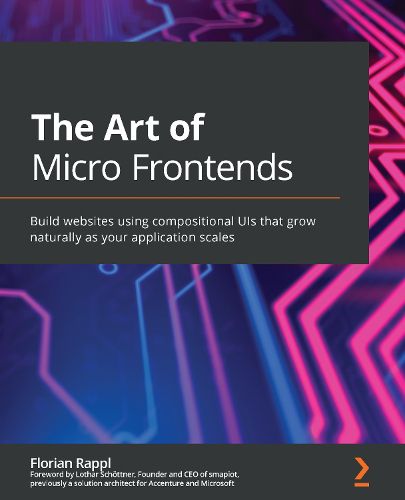Readings Newsletter
Become a Readings Member to make your shopping experience even easier.
Sign in or sign up for free!
You’re not far away from qualifying for FREE standard shipping within Australia
You’ve qualified for FREE standard shipping within Australia
The cart is loading…






This title is printed to order. This book may have been self-published. If so, we cannot guarantee the quality of the content. In the main most books will have gone through the editing process however some may not. We therefore suggest that you be aware of this before ordering this book. If in doubt check either the author or publisher’s details as we are unable to accept any returns unless they are faulty. Please contact us if you have any questions.
Apply your experience of web development with HTML and JavaScript to build micro frontends for large-scale web projects using frameworks such as React and popular web tooling such as Node.js with Express or webpack
Key Features
Cut through the complexities of designing a monolithic web architecture using micro frontend architecture Explore architecture patterns for building large-scale applications Learn how to build, test, and secure your micro frontends efficiently
Book DescriptionMicro frontend is a web architecture for frontend development borrowed from the idea of microservices in software development, where each module of the frontend is developed and shipped in isolation to avoid complexity and a single point of failure for your frontend.
Complete with hands-on tutorials, projects, and self-assessment questions, this easy-to-follow guide will take you through the patterns available for implementing a micro frontend solution. You’ll learn about micro frontends in general, the different architecture styles and their areas of use, how to prepare teams for the change to micro frontends, as well as how to adjust the UI design for scalability. Starting with the simplest variants of micro frontend architectures, the book progresses from static approaches to fully dynamic solutions that allow maximum scalability with faster release cycles. In the concluding chapters, you’ll reinforce the knowledge you’ve gained by working on different case studies relating to micro frontends.
By the end of this book, you’ll be able to decide if and how micro frontends should be implemented to achieve scalability for your user interface (UI).
What you will learn
Understand how to choose the right micro frontend architecture Design screens for compositional UIs Create a great developer experience for micro frontend solutions Achieve enhanced user experiences with micro frontends Introduce governance and boundary checks for managing distributed frontends Build scalable modular web applications from scratch or by migrating an existing monolith
Who this book is forThis book is for software/solution architects or (mostly lead) developers as well as web developers and frontend engineers. Beginner-level knowledge of HTML and CSS along with a solid understanding of JavaScript programming and its ecosystem, including Node.js and NPM, is assumed.
$9.00 standard shipping within Australia
FREE standard shipping within Australia for orders over $100.00
Express & International shipping calculated at checkout
This title is printed to order. This book may have been self-published. If so, we cannot guarantee the quality of the content. In the main most books will have gone through the editing process however some may not. We therefore suggest that you be aware of this before ordering this book. If in doubt check either the author or publisher’s details as we are unable to accept any returns unless they are faulty. Please contact us if you have any questions.
Apply your experience of web development with HTML and JavaScript to build micro frontends for large-scale web projects using frameworks such as React and popular web tooling such as Node.js with Express or webpack
Key Features
Cut through the complexities of designing a monolithic web architecture using micro frontend architecture Explore architecture patterns for building large-scale applications Learn how to build, test, and secure your micro frontends efficiently
Book DescriptionMicro frontend is a web architecture for frontend development borrowed from the idea of microservices in software development, where each module of the frontend is developed and shipped in isolation to avoid complexity and a single point of failure for your frontend.
Complete with hands-on tutorials, projects, and self-assessment questions, this easy-to-follow guide will take you through the patterns available for implementing a micro frontend solution. You’ll learn about micro frontends in general, the different architecture styles and their areas of use, how to prepare teams for the change to micro frontends, as well as how to adjust the UI design for scalability. Starting with the simplest variants of micro frontend architectures, the book progresses from static approaches to fully dynamic solutions that allow maximum scalability with faster release cycles. In the concluding chapters, you’ll reinforce the knowledge you’ve gained by working on different case studies relating to micro frontends.
By the end of this book, you’ll be able to decide if and how micro frontends should be implemented to achieve scalability for your user interface (UI).
What you will learn
Understand how to choose the right micro frontend architecture Design screens for compositional UIs Create a great developer experience for micro frontend solutions Achieve enhanced user experiences with micro frontends Introduce governance and boundary checks for managing distributed frontends Build scalable modular web applications from scratch or by migrating an existing monolith
Who this book is forThis book is for software/solution architects or (mostly lead) developers as well as web developers and frontend engineers. Beginner-level knowledge of HTML and CSS along with a solid understanding of JavaScript programming and its ecosystem, including Node.js and NPM, is assumed.